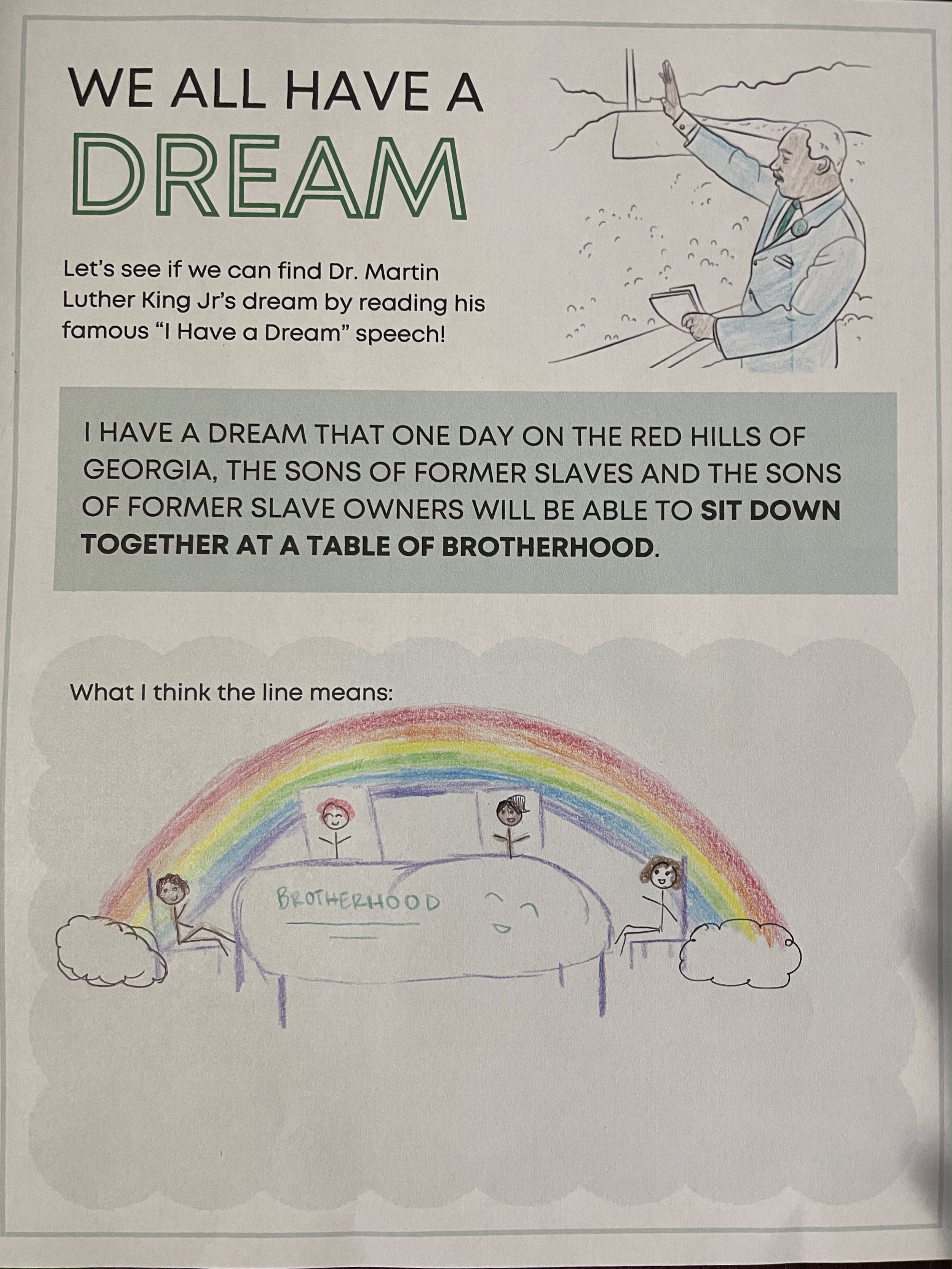We All Have A Dream: 5th Grade Social Studies
Lesson Objective:
This activity is designed to teach young dyslexic learners about the actions and impact of Dr. Martin Luther King Jr. while strengthening reading fluency through a “Structured Literacy” analysis of his “I Have a Dream” speech.
The activity specifically targets the Grade 5 New Jersey Student Learning Standards for Social Studies performance expectation to research and cite evidence for the actions of Dr. Martin Luther King, Jr. and other historical civil rights leaders that served as catalysts for social change and inspired social activism in subsequent generations. Fulfilling this expectation ultimately builds toward the target core idea that it is the responsibility of individuals and institutions at the state, national, and international levels to promote human rights, and that students themselves have the ability to realize their own dreams if they put in the necessary effort.
Materials:
Activity Guide printouts
Coloring and drawing materials
Poster paper
Pre-Activity Set-Up (for Parents and Teachers):
Print activity guide for each student
Recommended to do lesson with group of students
Gather plenty of coloring materials and poster paper!
Optional Recommended Pre-Activity
Provide background lesson about Dr. King and the “I Have a Dream” speech
Recommended materials
Have a brief preliminary discussion about Dr. King, his cause regarding the Civil Rights Movement, and his dream for the nation; consider the following questions to help students connect to the subject emotionally:
How do you think it would feel to be excluded based on how you look? Where you are from? How much money you have or do not have?
How would you feel if someone told you that your dream could never come true?
How do you think our thoughts and feelings impact what we do in life and what type of person we become?
How do you believe Dr. King felt prior to creating this speech? What was his goal?
Activity:
Read aloud each excerpt on the activity guide and have students repeat them slowly
This is encouraged to be a collaborative and gradual process, as some words may be tricky. It may also be helpful to allow each person in the group to take an excerpt in the guide (there are six in total)
Discuss meaning of each excerpt as a group; guide the conversation so it connects to earlier discussion regarding the context/background of the speech
Have each student draw and color what they think the excerpt means in the space provided on the activity guide
Promote originality in the drawings, but make an effort to concentrate on the key (bold) words of each excerpt
Share and discuss as a group:
What did you draw and why did you draw it? How did it feel to create it?
How does this relate to the meaning of that excerpt, as previously discussed?
At the end, have each student draw their own “Dream Mural” about their own hopes and dreams for the future
If students are comfortable, showcase the murals at the end and ask them to share: How would you feel if your dream were to come true?
Optional: Color the MLK images in the top right corner of each page along the way!
Sample Activity Guide Analysis
Sample Dream Mural
Post-Activity Reflection and Discussion:
Facilitate discussion about Dr. King’s cause and impact, inspire students’ own dreams
Possible questions to guide discussion can include:
What was MLK’s dream?
Did his dream “come true”? Where do we see this in society?
Share murals and have students consider:
What are my dreams and hopes for the future?
How do I want to see this in my own life and society?
Practice the Coloring Confidence affirmation (see below)
Learning More for Parents:
What is procedural learning?
How dyslexia can impact reading comprehension?
Reading comprehension can be difficult for young learners with dyslexia, who often struggle with phonological processing. Phonological processing involves using sounds (phonemes) to process spoken and written language (Wagner, R. K., & Torgesen, J. K. (1987)). Effective phonological processing requires both “phonemic awareness,” or the ability to recognize the sound structure of a word, as well as strong “phonological working memory,” or the cognitive process one’s mind uses to retain and use phonemic awareness for other purposes, such as reading. As dyslexia impedes phonological processing and working memory, learners with dyslexia may struggle establishing the foundational reading skills necessary for strong reading fluency and comprehension skills. (https://bedrocklearning.org/)
What can you do to help your child?
The difference between “Guided Reading” vs. “Structured Literacy”
The widely implemented “Guided Reading” or “Balanced Literacy” approaches to reading are often not effective for struggling readers, especially those with dyslexia, as they fail to address the “decoding skills” such students need to strengthen their reading fluency and comprehension. On the other hand, “Structured Literacy” instruction specifically highlights strategies to help students decode words in an explicit and systematic manner. In contrast to “Guided Reading,” which often allows for more hands-off interpretation and processing of the text, Structured Literacy instruction employs “explicit intervention,” which requires personalized and continuous student-teacher interaction to foster learning in a systematic and cumulative manner. (International Dyslexia Association)
Practice the Coloring Confidence Affirmation & Meditation!
Created by Isabella Thomas
Join Dr. Pali to reflect on your We All Have A Dream project!




